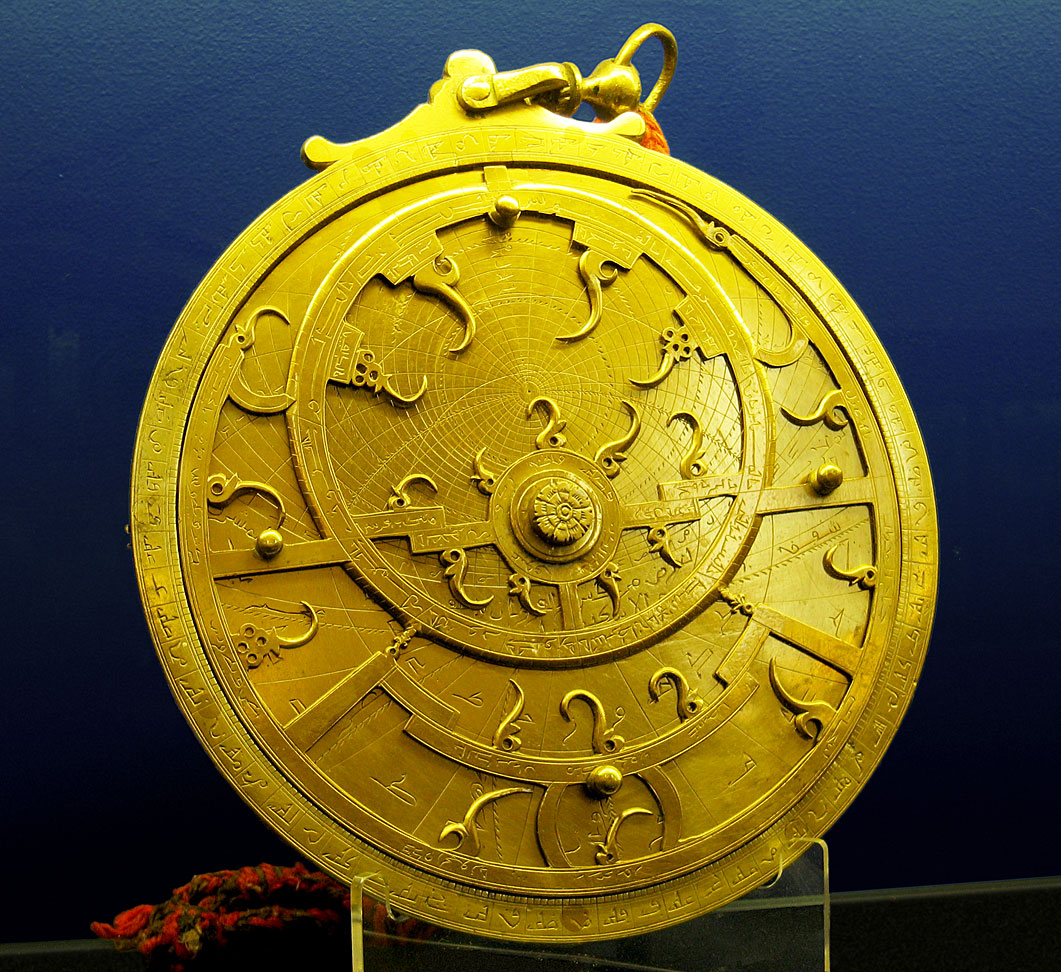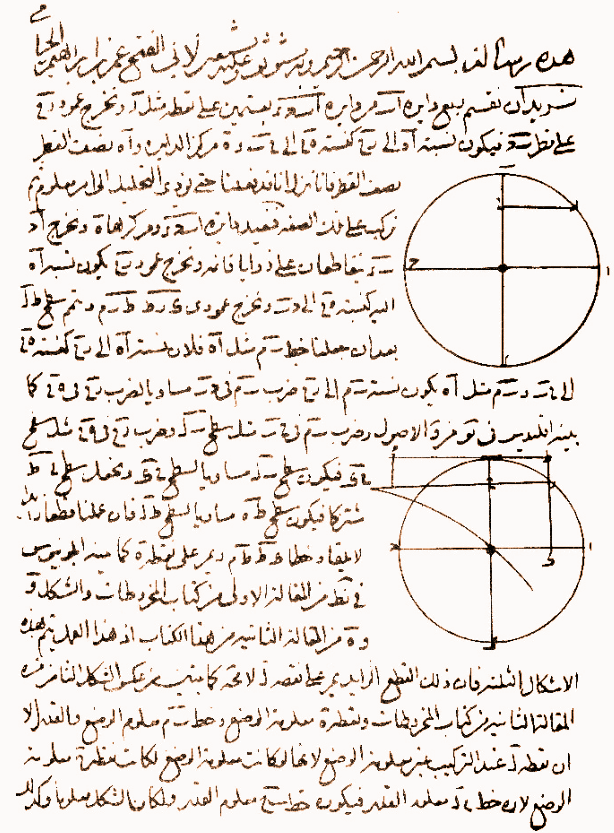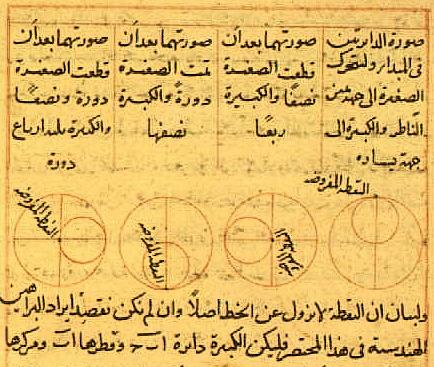|
Al-Khazini
Abū al-Fath Abd al-Rahman Mansūr al-Khāzini or simply al-Khāzini (, flourished 1115–1130) was an Iranian astronomer, mechanician and physicist of Byzantine Greek origin who lived during the Seljuk Empire. His astronomical tables, written under the patronage of Sultan Sanjar (', 1115), are considered to be one of the major works in mathematical astronomy of the medieval period. Montelle, C. (2011). The ‘Well-Known Calendars’: Al-Khāzinī’s Description of Significant Chronological Systems for Medieval Mathematical Astronomy in Arabic. In Steele J. (Ed.), Calendars and Years II: Astronomy and Time in the Ancient and Medieval World (pp. 107-126). Oxford; Oakville: Oxbow Books. He is considered to have been one of the greatest scientists of his era, among the greatest makers of scientific instruments of any time, and as "the physicist of all physicists". Al-Khazini is one of the few Islamic astronomers to be known for doing original observations. He provided the po ... [...More Info...] [...Related Items...] OR: [Wikipedia] [Google] [Baidu] |
Al-Isfizari
Abū Ḥātim al-Muẓaffar al-Isfazārī (; fl. late 11th or early 12th century) was an Islamic mathematician, astronomer and engineer from Khurasan. According to the historian and geographer Ibn al-Athir and the polymath Qutb al-Din al-Shirazi, he worked in the Seljuq observatory of Isfahan. The Persian writer Nezami Aruzi met him in Balkh in (in present-day Afghanistan) in 1112 or 1113. Al-Isfazārī was a contemporary of the Persian polymath Umar al-Khayyam and the Persian astronomer Al-Khazini. Al-Isfazārī's main surviving work, (''Guiding the Possessors of Learning in the Art of the Steelyard''), sets out the theory of the steelyard balance with unequal arms. His other surviving works include a summary of Euclid's ''Elements'', a text on geometrical measurements, and a treatise in Persian on meteorology. Al-Isfazārī's corpus of mechanics Mechanics () is the area of physics concerned with the relationships between force, matter, and motion among Physi ... [...More Info...] [...Related Items...] OR: [Wikipedia] [Google] [Baidu] |
Islamic Astronomy
Medieval Islamic astronomy comprises the astronomical developments made in the Islamic world, particularly during the Islamic Golden Age (9th–13th centuries), and mostly written in the Arabic language. These developments mostly took place in the Middle East, Central Asia, Al-Andalus, and North Africa, and later in the Far East and India. It closely parallels the genesis of other Islamic sciences in its assimilation of foreign material and the amalgamation of the disparate elements of that material to create a science with Islamic characteristics. These included Greek, Sassanid, and Indian works in particular, which were translated and built upon. Islamic astronomy played a significant role in the revival of ancient astronomy following the loss of knowledge during the early medieval period, notably with the production of Latin translations of Arabic works during the 12th century. A significant number of stars in the sky, such as Aldebaran, Altair and Deneb, and astrono ... [...More Info...] [...Related Items...] OR: [Wikipedia] [Google] [Baidu] |
Omar Khayyam
Ghiyāth al-Dīn Abū al-Fatḥ ʿUmar ibn Ibrāhīm Nīshābūrī (18 May 1048 – 4 December 1131) (Persian language, Persian: غیاث الدین ابوالفتح عمر بن ابراهیم خیام نیشابورﻯ), commonly known as Omar Khayyam (), was a Persian poet and polymath, known for his contributions to Mathematics in medieval Islam, mathematics, Astronomy in the medieval Islamic world, astronomy, Iranian philosophy, philosophy, and Persian literature. He was born in Nishapur, Iran and lived during the Seljuk Empire, Seljuk era, around the time of the First Crusade. As a mathematician, he is most notable for his work on the classification and solution of cubic equations, where he provided a geometric formulation based on the intersection of conics. He also contributed to a deeper understanding of Euclid's parallel axiom. As an astronomer, he calculated the duration of the solar year with remarkable precision and accuracy, and designed the Jalali calendar, a solar ... [...More Info...] [...Related Items...] OR: [Wikipedia] [Google] [Baidu] |
Astronomy In Medieval Islam
Medieval Islamic astronomy comprises the Astronomy, astronomical developments made in the Islamic world, particularly during the Islamic Golden Age (9th–13th centuries), and mostly written in the Arabic language. These developments mostly took place in the Middle East, Central Asia, Al-Andalus, and North Africa, and later in the Far East and History of India, India. It closely parallels the genesis of other Islamic sciences in its assimilation of foreign material and the amalgamation of the disparate elements of that material to create a science with Islamic characteristics. These included Greek astronomy, Greek, Sassanid Empire, Sassanid, and Indian astronomy, Indian works in particular, which were translated and built upon. Islamic astronomy played a significant role in the revival of ancient astronomy following the Dark Ages (historiography), loss of knowledge during the early medieval period, notably with the production of Middle Latin, Latin translations of Arabic works La ... [...More Info...] [...Related Items...] OR: [Wikipedia] [Google] [Baidu] |
Islamic Science
Science in the medieval Islamic world was the science developed and practised during the Islamic Golden Age under the Abbasid Caliphate of Baghdad, the Umayyads of Córdoba, the Abbadids of Seville, the Samanids, the Ziyarids and the Buyids in Persia and beyond, spanning the period roughly between 786 and 1258. Islamic scientific achievements encompassed a wide range of subject areas, especially astronomy, mathematics, and medicine. Other subjects of scientific inquiry included alchemy and chemistry, botany and agronomy, geography and cartography, ophthalmology, pharmacology, physics, and zoology. Medieval Islamic science had practical purposes as well as the goal of understanding. For example, astronomy was useful for determining the ''Qibla'', the direction in which to pray, botany had practical application in agriculture, as in the works of Ibn Bassal and Ibn al-'Awwam, and geography enabled Abu Zayd al-Balkhi to make accurate maps. Islamic mathematicians such as Al-K ... [...More Info...] [...Related Items...] OR: [Wikipedia] [Google] [Baidu] |
Scientific Instrument
A scientific instrument is a device or tool used for scientific purposes, including the study of both natural phenomena and theoretical research. History Historically, the definition of a scientific instrument has varied, based on usage, laws, and historical time period. Before the mid-nineteenth century such tools were referred to as "natural philosophical" or "philosophical" apparatus and instruments, and older tools from antiquity to the Middle Ages (such as the astrolabe and pendulum clock) defy a more modern definition of "a tool developed to investigate nature qualitatively or quantitatively." Scientific instruments were made by mathematical practitioner, instrument makers living near a center of learning or research, such as a university or research laboratory. Instrument makers designed, constructed, and refined instruments for purposes, but if demand was sufficient, an instrument would go into production as a commercial product. In a description of the use of the eudiomet ... [...More Info...] [...Related Items...] OR: [Wikipedia] [Google] [Baidu] |
Dinar
The dinar () is the name of the principal currency unit in several countries near the Mediterranean Sea, with a more widespread historical use. The English word "dinar" is the transliteration of the Arabic دينار (''dīnār''), which was borrowed via the Syriac language, Syriac ''dīnarā'' from the Latin language , Latin Denarius , ''dēnārius''. The modern gold dinar is a projected bullion gold coin, and is not issued as an official currency by any state. History The modern dinar's historical antecedents are the gold dinar and the silver dirham, the main coin of the medieval Islamic empires, first issued in Islamic calendar, AH 77 (696–697 AD) (Late Antiquity) by Caliph Abd al-Malik ibn Marwan. The word "dinar" derives from the Latin word "denarius, ''dēnārius''," a silver coin of Ancient Roman coinage, ancient Rome, which was first minted about c. 211 BC. The Kushan Empire introduced a gold coin known as the ''dīnāra'' in India in the 1st century ... [...More Info...] [...Related Items...] OR: [Wikipedia] [Google] [Baidu] |
Oneworld Publications
Oneworld Publications is a British independent publishing firm founded in 1986 by Novin Doostdar and Juliet Mabey originally to publish accessible non-fiction by experts and academics for the general market. Based in London, it later added a literary fiction list (in 2009) and both a children's list (Rock the Boat, 2015) and an upmarket crime list (Point Blank, 2016), and now publishes across a wide range of subjects, including history, politics, current affairs, popular science, religion, philosophy, and psychology, as well as literary fiction, crime fiction and suspense, and children's titles. History Oneworld Publications was founded in 1986 by Novin Doostdar and Juliet Mabey, who had met as students in the 1970s and subsequently married;Alison Flood"Oneworld: the tiny publisher behind the last two Man Booker winners" ''The Guardian'', 15 November 2016. the company's name reflects their international approach to publishing with global values, initially producing non-fiction " ... [...More Info...] [...Related Items...] OR: [Wikipedia] [Google] [Baidu] |
Jalali Calendar
The Jalali calendar, also referred to as ''Malikshahi'' and ''Maliki'', is a solar calendar compiled during the reign of Jalaluddin Malik-Shah I, the Sultan of the Seljuk Empire (1072–1092 CE), by the order of Grand Vizier Nizam al-Mulk, using observations made in the cities of Isfahan (the capital of the Seljuks), Rey, and Nishapur. Variants of the Jalali calendar are still in use today in Iran and Afghanistan. In Iran, the Persian names of the zodiac are used, while in Afghanistan the original Arabic names are used. The Jalali calendar gains approximately 1 day on the Julian calendar every 128 years. The tropical Jalali calendar (), which inherited some aspects from the Yazdgerdi calendar, was adopted on 15 March 1079 by the Sultan, based on the recommendations of a committee of astronomers, including Omar Khayyam, at the imperial observatory in the capital city of Isfahan. It was Khayyam who positioned Isfahan as the prime meridian, otherwise known as the nasf. Month co ... [...More Info...] [...Related Items...] OR: [Wikipedia] [Google] [Baidu] |
Greater Khorasan
KhorasanDabeersiaghi, Commentary on Safarnâma-e Nâsir Khusraw, 6th Ed. Tehran, Zavvâr: 1375 (Solar Hijri Calendar) 235–236 (; , ) is a historical eastern region in the Iranian Plateau in West Asia, West and Central Asia that encompasses western and northern Afghanistan, northeastern Iran, the eastern halves of Turkmenistan and Uzbekistan, western Tajikistan, and portions of Kyrgyzstan and Kazakhstan. The extent of the region referred to as ''Khorasan'' varied over time. In its stricter historical sense, it comprised the present territories of Khorasan Province, northeastern Iran, parts of Afghanistan and southern parts of Central Asia, extending as far as the Amu Darya (Oxus) river. However, the name has often been used in a loose sense to include a wider region that included most of Transoxiana (encompassing Bukhara and Samarqand in present-day Uzbekistan), extended westward to the Caspian Sea, Caspian coast and to the Dasht-e Kavir southward to Sistan, and eastward to t ... [...More Info...] [...Related Items...] OR: [Wikipedia] [Google] [Baidu] |
Greeks
Greeks or Hellenes (; , ) are an ethnic group and nation native to Greece, Greek Cypriots, Cyprus, Greeks in Albania, southern Albania, Greeks in Turkey#History, Anatolia, parts of Greeks in Italy, Italy and Egyptian Greeks, Egypt, and to a lesser extent, other countries surrounding the Eastern Mediterranean and Black Sea. They also form a significant Greek diaspora, diaspora (), with many Greek communities established around the world.. Greek colonies and communities have been historically established on the shores of the Mediterranean Sea and Black Sea, but the Greek people themselves have always been centered on the Aegean Sea, Aegean and Ionian Sea, Ionian seas, where the Greek language has been spoken since the Bronze Age.. Until the early 20th century, Greeks were distributed between the Greek peninsula, the western coast of Asia Minor, the Black Sea coast, Cappadocia in central Anatolia, Egypt, the Balkans, Cyprus, and Constantinople. Many of these regions coincided to ... [...More Info...] [...Related Items...] OR: [Wikipedia] [Google] [Baidu] |
Middle Ages
In the history of Europe, the Middle Ages or medieval period lasted approximately from the 5th to the late 15th centuries, similarly to the post-classical period of global history. It began with the fall of the Western Roman Empire and transitioned into the Renaissance and the Age of Discovery. The Middle Ages is the middle period of the three traditional divisions of Western history: classical antiquity, the medieval period, and the modern period. The medieval period is itself subdivided into the Early, High, and Late Middle Ages. Population decline, counterurbanisation, the collapse of centralised authority, invasions, and mass migrations of tribes, which had begun in late antiquity, continued into the Early Middle Ages. The large-scale movements of the Migration Period, including various Germanic peoples, formed new kingdoms in what remained of the Western Roman Empire. In the 7th century, North Africa and the Middle East—once part of the Byzantine Empire� ... [...More Info...] [...Related Items...] OR: [Wikipedia] [Google] [Baidu] |



